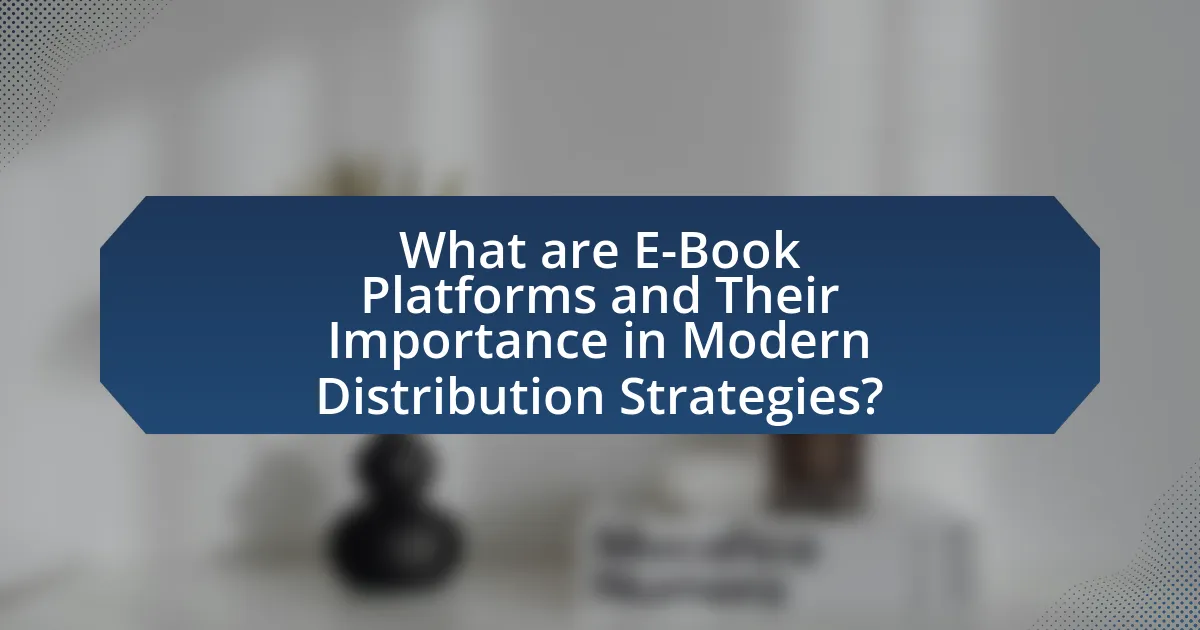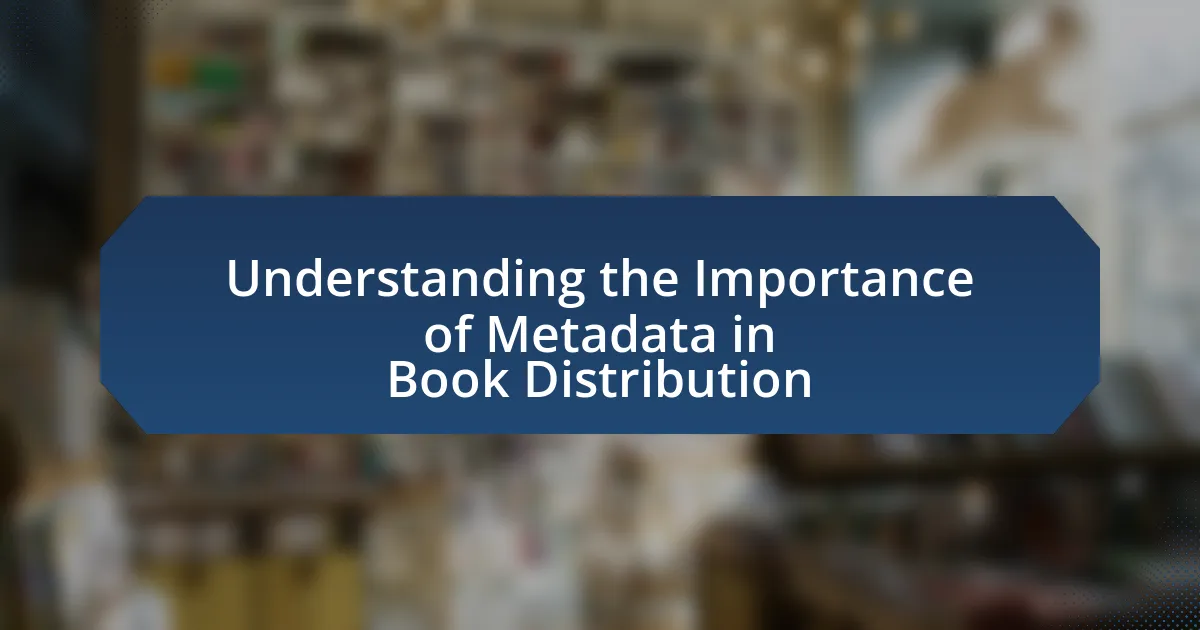E-book platforms are digital services that enable the distribution, sale, and reading of electronic books, playing a vital role in modern distribution strategies. This article explores the functionality of these platforms, including their technological underpinnings, advantages for authors and publishers, and the challenges they face in distribution. It also examines how consumer behavior is influenced by e-book platforms, the impact of pricing strategies, and the importance of user experience and personalization. Additionally, the article discusses emerging technologies shaping the future of e-book platforms and best practices for authors and publishers to maximize their reach and engagement.

What are E-Book Platforms and Their Importance in Modern Distribution Strategies?
E-book platforms are digital services that facilitate the distribution, sale, and reading of electronic books. These platforms, such as Amazon Kindle, Apple Books, and Google Play Books, are crucial in modern distribution strategies as they provide authors and publishers with direct access to a global audience, enabling efficient and cost-effective distribution. According to a report by Statista, the global e-book market was valued at approximately $18 billion in 2020 and is projected to grow, highlighting the increasing reliance on digital formats for content consumption. This growth underscores the importance of e-book platforms in reaching diverse demographics and adapting to changing consumer preferences in the publishing industry.
How do E-Book Platforms function in the digital marketplace?
E-book platforms function as digital marketplaces that facilitate the distribution, sale, and consumption of electronic books. These platforms, such as Amazon Kindle, Apple Books, and Google Play Books, provide authors and publishers with a space to upload their content, set pricing, and manage sales. They utilize digital rights management (DRM) to protect intellectual property and often offer features like user reviews, recommendations, and personalized reading experiences to enhance user engagement.
According to a report by Statista, the global e-book market was valued at approximately $18 billion in 2020 and is projected to grow, indicating the significant role these platforms play in modern distribution strategies. The convenience of instant access and the ability to reach a global audience further solidify their importance in the digital marketplace.
What technologies underpin E-Book Platforms?
E-Book platforms are primarily underpinned by technologies such as digital rights management (DRM), ePub and PDF formats, cloud storage, and mobile applications. DRM technology protects copyright by controlling access to e-books, ensuring that only authorized users can read them. The ePub and PDF formats are widely used for their compatibility across various devices and ease of formatting. Cloud storage enables users to access their e-books from multiple devices seamlessly, while mobile applications provide user-friendly interfaces for reading and managing e-books. These technologies collectively enhance the accessibility, security, and usability of e-books, making them integral to modern distribution strategies in the publishing industry.
How do E-Book Platforms facilitate content delivery?
E-Book platforms facilitate content delivery by providing a digital infrastructure that allows users to access, purchase, and read e-books seamlessly. These platforms utilize cloud storage to host vast libraries of titles, enabling instant access from various devices such as e-readers, tablets, and smartphones. Additionally, they employ digital rights management (DRM) to protect content while ensuring that users can easily download and read purchased materials. According to a report by the Association of American Publishers, e-book sales accounted for 20% of the overall book market in 2020, highlighting the effectiveness of these platforms in reaching a wide audience and delivering content efficiently.
Why are E-Book Platforms essential for authors and publishers?
E-Book platforms are essential for authors and publishers because they provide a streamlined distribution channel that enhances accessibility and reach. These platforms enable authors to publish their work digitally, allowing for immediate availability to a global audience, which is crucial in a market where traditional print distribution can be slow and costly. According to a report by the Association of American Publishers, e-book sales accounted for 20% of the total book market in 2020, highlighting the growing importance of digital formats. Furthermore, e-book platforms often offer tools for marketing, analytics, and direct sales, empowering authors and publishers to engage with readers effectively and optimize their sales strategies.
What advantages do E-Book Platforms provide for independent authors?
E-Book platforms provide independent authors with increased visibility and access to a global audience. These platforms, such as Amazon Kindle Direct Publishing and Smashwords, enable authors to publish their work without traditional gatekeepers, allowing for greater creative freedom and control over pricing. Additionally, e-book platforms often offer marketing tools and analytics that help authors track sales and reader engagement, enhancing their ability to promote their work effectively. According to a 2021 report by the Independent Book Publishers Association, self-published authors who utilize e-book platforms can earn up to 70% royalties on their sales, significantly higher than the typical 10-15% offered by traditional publishing houses.
How do E-Book Platforms enhance visibility for publishers?
E-Book platforms enhance visibility for publishers by providing a broad distribution network that reaches a global audience. These platforms, such as Amazon Kindle, Apple Books, and Google Play Books, aggregate numerous titles, making it easier for readers to discover new works through search algorithms, recommendations, and curated lists. For instance, Amazon’s recommendation engine can increase a book’s visibility significantly, as it suggests titles based on user preferences and purchasing history. Additionally, e-book platforms often feature promotional tools like discounts, free trials, and featured placements, which can further elevate a publisher’s title in a crowded marketplace. This combination of extensive reach and targeted marketing strategies effectively boosts the visibility of publishers’ works.
What challenges do E-Book Platforms face in distribution?
E-Book platforms face significant challenges in distribution, primarily due to copyright issues, market fragmentation, and technological barriers. Copyright issues arise as platforms must navigate complex licensing agreements with publishers and authors, which can limit the availability of titles and complicate distribution rights. Market fragmentation occurs because different regions have varying regulations and consumer preferences, making it difficult for platforms to offer a consistent catalog globally. Additionally, technological barriers, such as compatibility with various devices and formats, can hinder user access and limit the reach of e-books. These challenges collectively impact the efficiency and effectiveness of e-book distribution strategies.
How do copyright issues impact E-Book distribution?
Copyright issues significantly impact E-Book distribution by determining the legal rights of authors and publishers over their digital content. These legal frameworks dictate how E-Books can be sold, shared, and accessed, influencing pricing strategies and availability on various platforms. For instance, strict copyright laws can limit the distribution of E-Books to authorized retailers, thereby affecting market reach and sales potential. Additionally, copyright infringement can lead to legal disputes, which may result in financial penalties and restrictions on distribution channels. According to the U.S. Copyright Office, unauthorized reproduction or distribution of copyrighted works can incur statutory damages ranging from $750 to $30,000 per work, emphasizing the importance of adhering to copyright regulations in E-Book distribution.
What are the barriers to entry for new E-Book Platforms?
The barriers to entry for new e-book platforms include high initial investment costs, established competition, and complex copyright regulations. High initial investment costs arise from the need for technology infrastructure, content acquisition, and marketing efforts. Established competition, such as Amazon Kindle and Apple Books, creates a challenging environment for new entrants due to their significant market share and brand loyalty. Additionally, complex copyright regulations require new platforms to navigate licensing agreements and intellectual property laws, which can be resource-intensive and legally intricate. These factors collectively hinder the ability of new e-book platforms to successfully enter and compete in the market.
How do E-Book Platforms influence consumer behavior?
E-Book platforms significantly influence consumer behavior by providing instant access to a vast library of titles, which encourages impulsive purchasing and increases reading frequency. The convenience of digital formats allows consumers to buy and download books immediately, often leading to higher sales volumes; for instance, a study by the Pew Research Center found that 28% of Americans read e-books in 2021, reflecting a growing trend towards digital consumption. Additionally, personalized recommendations and user reviews on these platforms shape purchasing decisions, as consumers are more likely to buy books that are suggested based on their previous reading habits. This data-driven approach enhances user engagement and fosters a culture of continuous reading, ultimately altering traditional consumer behavior in the book market.
What factors drive consumer preferences for E-Book Platforms?
Consumer preferences for E-Book platforms are primarily driven by factors such as content availability, user interface, pricing, and device compatibility. Content availability is crucial, as platforms offering a wide range of titles, including bestsellers and niche genres, attract more users. A user-friendly interface enhances the reading experience, making navigation and accessibility easier, which is essential for retaining users. Pricing strategies, including subscription models and discounts, significantly influence consumer choices, as competitive pricing can lead to higher adoption rates. Additionally, compatibility with various devices, such as e-readers, tablets, and smartphones, ensures that consumers can access their books anytime and anywhere, further driving preference for specific platforms. These factors collectively shape the decision-making process for consumers when selecting E-Book platforms.
How do pricing strategies affect consumer choices on E-Book Platforms?
Pricing strategies significantly influence consumer choices on e-book platforms by determining perceived value and accessibility. For instance, competitive pricing can attract price-sensitive consumers, while premium pricing may appeal to those seeking exclusive content or features. Research indicates that discounts and promotional pricing can lead to increased sales volume; a study by the National Bureau of Economic Research found that a 10% discount can boost sales by up to 30%. Additionally, subscription models, such as Kindle Unlimited, provide consumers with access to a vast library for a fixed monthly fee, altering their purchasing behavior by encouraging exploration of diverse titles without the commitment of individual purchases. Thus, effective pricing strategies directly shape consumer engagement and purchasing decisions on e-book platforms.

What are the Key Features of Successful E-Book Platforms?
Successful e-book platforms typically feature a user-friendly interface, extensive content library, robust search functionality, and cross-device compatibility. A user-friendly interface enhances navigation and accessibility, which is crucial for retaining readers. An extensive content library ensures a diverse selection of titles, catering to various genres and reader preferences, which is supported by data indicating that platforms with larger libraries attract more users. Robust search functionality allows users to easily find specific titles or authors, improving user experience and engagement. Cross-device compatibility enables seamless reading across multiple devices, which is essential as studies show that 70% of readers prefer to switch between devices. These features collectively contribute to the effectiveness and popularity of e-book platforms in modern distribution strategies.
How do user experience and interface design impact E-Book Platforms?
User experience and interface design significantly impact e-book platforms by influencing user engagement and satisfaction. A well-designed interface enhances navigation, making it easier for users to find and access content, which can lead to increased reading time and retention rates. For instance, research by Nielsen Norman Group indicates that users are more likely to return to platforms that offer intuitive navigation and visually appealing layouts. Additionally, effective user experience design can reduce cognitive load, allowing readers to focus on content rather than struggling with the interface. This is supported by a study published in the Journal of Usability Studies, which found that platforms with streamlined user experiences saw a 30% increase in user satisfaction ratings. Thus, user experience and interface design are critical for the success of e-book platforms, directly affecting user retention and overall platform performance.
What role does personalization play in user engagement on E-Book Platforms?
Personalization significantly enhances user engagement on E-Book platforms by tailoring content recommendations to individual preferences and reading habits. This customization leads to increased user satisfaction, as studies show that personalized recommendations can boost engagement metrics by up to 30%. For instance, platforms like Kindle utilize algorithms that analyze user behavior, such as reading history and ratings, to suggest relevant titles, thereby fostering a more immersive reading experience. This targeted approach not only keeps users returning but also encourages them to explore new genres and authors, ultimately driving higher retention rates and sales for the platform.
How do E-Book Platforms ensure accessibility for diverse audiences?
E-Book platforms ensure accessibility for diverse audiences by implementing features such as adjustable font sizes, text-to-speech options, and compatibility with screen readers. These features cater to individuals with visual impairments, learning disabilities, or varying reading preferences. For instance, platforms like Kindle and Apple Books offer customizable reading experiences, allowing users to change background colors and font styles, which enhances readability for those with dyslexia. Additionally, many e-book platforms adhere to the Web Content Accessibility Guidelines (WCAG), ensuring that their content is navigable and usable for people with disabilities. This commitment to accessibility is further supported by statistics indicating that approximately 15% of the global population experiences some form of disability, highlighting the importance of inclusive design in digital reading environments.
What marketing strategies are effective for E-Book Platforms?
Effective marketing strategies for E-Book platforms include targeted social media advertising, content marketing through blogs and newsletters, and partnerships with authors and influencers. Targeted social media advertising allows platforms to reach specific demographics, increasing visibility and engagement; for instance, Facebook and Instagram ads can be tailored to users interested in specific genres. Content marketing, such as providing valuable insights and recommendations through blogs and newsletters, helps establish authority and attract potential readers. Additionally, partnerships with authors and influencers can leverage their existing audiences, enhancing credibility and driving traffic to the platform. According to a study by the Book Industry Study Group, 70% of readers discover new books through social media, highlighting the effectiveness of these strategies.
How can social media be leveraged to promote E-Book Platforms?
Social media can be leveraged to promote E-Book platforms by utilizing targeted advertising, engaging content, and community building. Targeted advertising on platforms like Facebook and Instagram allows E-Book platforms to reach specific demographics, increasing visibility among potential readers. Engaging content, such as excerpts, author interviews, and interactive posts, can attract users and encourage sharing, which amplifies reach. Additionally, building a community through groups or forums fosters discussions around books and reading, enhancing user loyalty and driving traffic to the E-Book platform. According to a report by Statista, 54% of social media users use these platforms to discover new content, highlighting the effectiveness of social media in promoting E-Book platforms.
What role do partnerships play in expanding E-Book Platform reach?
Partnerships significantly enhance the reach of E-Book platforms by facilitating access to broader audiences and diverse content offerings. Collaborations with publishers, educational institutions, and technology companies enable E-Book platforms to expand their catalogs, attract new users, and penetrate different market segments. For instance, partnerships with educational institutions can lead to the integration of E-Book platforms into academic curricula, thereby increasing user engagement and subscription rates. Additionally, alliances with technology firms can improve platform functionality and user experience, making it more appealing to potential customers. These strategic partnerships are essential for driving growth and establishing a competitive edge in the rapidly evolving digital publishing landscape.
What metrics are used to evaluate the success of E-Book Platforms?
E-Book platforms are evaluated for success using metrics such as user engagement, sales figures, customer retention rates, and content availability. User engagement can be measured through metrics like daily active users and average reading time, indicating how often and how long users interact with the platform. Sales figures, including total revenue and number of transactions, provide a direct measure of financial success. Customer retention rates reflect the platform’s ability to keep users returning, often assessed through subscription renewals or repeat purchases. Content availability, including the diversity and quantity of titles offered, impacts user satisfaction and platform attractiveness. These metrics collectively provide a comprehensive view of an e-book platform’s performance and market position.
How do sales figures correlate with user engagement metrics?
Sales figures positively correlate with user engagement metrics, indicating that higher engagement often leads to increased sales. For instance, a study by the Nielsen Company found that e-books with higher user ratings and reviews typically see a 20-30% increase in sales compared to those with lower engagement metrics. Additionally, platforms like Amazon report that books with more reader interactions, such as highlights and notes, tend to rank higher in sales, demonstrating a direct link between user engagement and purchasing behavior.
What are the key performance indicators for E-Book Platforms?
Key performance indicators for e-book platforms include user engagement metrics, sales conversion rates, customer retention rates, and average revenue per user. User engagement metrics, such as time spent reading and the number of books read per user, indicate how effectively the platform retains user interest. Sales conversion rates measure the percentage of visitors who make a purchase, reflecting the platform’s effectiveness in driving sales. Customer retention rates assess how many users continue to use the platform over time, which is crucial for long-term success. Average revenue per user provides insight into the platform’s profitability by calculating the revenue generated from each user. These indicators collectively help evaluate the performance and success of e-book platforms in the competitive digital marketplace.

How are E-Book Platforms Evolving in Response to Market Trends?
E-book platforms are evolving by integrating advanced technologies and diversifying content offerings to meet changing consumer preferences. For instance, platforms like Kindle and Apple Books are incorporating features such as personalized recommendations powered by artificial intelligence, which enhance user experience and engagement. Additionally, the rise of subscription models, exemplified by services like Scribd and Kindle Unlimited, reflects a shift towards providing unlimited access to a wide range of titles, catering to the demand for cost-effective reading options. Furthermore, the increasing popularity of audiobooks has prompted e-book platforms to expand their catalogs to include audio formats, thereby attracting a broader audience. These adaptations are supported by market research indicating that the global e-book market is projected to grow significantly, with a compound annual growth rate of over 4% from 2021 to 2026, highlighting the necessity for platforms to innovate in response to evolving market dynamics.
What emerging technologies are shaping the future of E-Book Platforms?
Emerging technologies shaping the future of e-book platforms include artificial intelligence, augmented reality, and blockchain. Artificial intelligence enhances personalized reading experiences through recommendation algorithms and adaptive learning systems, allowing platforms to tailor content to individual preferences. Augmented reality offers immersive reading experiences by integrating interactive elements, making literature more engaging. Blockchain technology ensures secure transactions and copyright protection, enabling authors to receive fair compensation for their work. These technologies collectively transform how readers interact with content and how publishers distribute it, reflecting a significant evolution in the e-book landscape.
How is artificial intelligence being integrated into E-Book Platforms?
Artificial intelligence is being integrated into e-book platforms through personalized recommendations, enhanced search functionalities, and automated content creation. These platforms utilize machine learning algorithms to analyze user behavior and preferences, allowing them to suggest titles that align with individual reading habits. For instance, Amazon’s Kindle employs AI to recommend books based on previous purchases and reading history, significantly improving user engagement. Additionally, AI-driven search tools enable users to find specific content within e-books more efficiently, while natural language processing is used to generate summaries and reviews, streamlining the content discovery process. This integration not only enhances user experience but also increases sales and retention rates for e-book platforms.
What impact does blockchain technology have on E-Book distribution?
Blockchain technology significantly enhances E-Book distribution by providing a decentralized platform that ensures transparency, security, and efficient royalty management. This technology allows authors and publishers to directly distribute their works without intermediaries, reducing costs and increasing profit margins. For instance, smart contracts can automate royalty payments, ensuring that authors receive their earnings promptly and accurately based on sales data recorded on the blockchain. According to a study by the University of Cambridge, blockchain can reduce transaction costs by up to 30% in digital content distribution, demonstrating its potential to transform the E-Book market.
How are consumer preferences changing the landscape of E-Book Platforms?
Consumer preferences are significantly shifting the landscape of E-Book platforms by driving demand for personalized content, subscription models, and enhanced user experiences. As readers increasingly seek tailored recommendations and diverse genres, platforms like Kindle Unlimited and Scribd have adapted by offering extensive libraries and personalized reading suggestions. Additionally, a 2022 survey by the Pew Research Center indicated that 30% of U.S. adults prefer subscription services for accessing books, highlighting a trend towards affordability and convenience. This shift is prompting E-Book platforms to innovate their offerings, integrating features such as social reading and interactive content to meet evolving consumer expectations.
What trends are influencing the types of content offered on E-Book Platforms?
The trends influencing the types of content offered on E-Book Platforms include the rise of self-publishing, increased demand for diverse genres, and the integration of multimedia elements. Self-publishing has empowered authors to bypass traditional publishing routes, leading to a surge in unique and niche content. According to a 2021 report by the Author Earnings Project, self-published e-books accounted for over 30% of the total e-book market, reflecting a significant shift in content availability. Additionally, readers are increasingly seeking diverse genres, including graphic novels and interactive stories, which has prompted platforms to expand their offerings. The incorporation of multimedia elements, such as audio and video, is also becoming prevalent, enhancing the reading experience and attracting a broader audience. This trend is supported by a 2022 survey from the Pew Research Center, which found that 45% of e-book readers expressed interest in interactive content.
How do subscription models affect user engagement on E-Book Platforms?
Subscription models significantly enhance user engagement on E-Book platforms by providing unlimited access to a vast library of titles for a fixed monthly fee. This model encourages users to explore diverse genres and authors, leading to increased reading frequency and time spent on the platform. Research indicates that platforms like Kindle Unlimited and Scribd report higher user retention rates, with subscribers reading more books compared to non-subscribers. For instance, a study by the Pew Research Center found that 30% of e-book readers who use subscription services read more than 20 books a year, compared to only 15% of those who purchase books individually. This increased engagement is driven by the low financial barrier to access multiple titles, fostering a habit of reading and discovery among users.
What best practices should authors and publishers follow when using E-Book Platforms?
Authors and publishers should ensure high-quality formatting and cover design when using e-book platforms. High-quality formatting enhances readability and user experience, which is crucial as studies show that well-formatted e-books lead to higher reader satisfaction and retention rates. Additionally, investing in professional cover design can significantly impact sales; research indicates that 75% of consumers judge a book by its cover.
Moreover, authors and publishers should optimize metadata, including keywords and descriptions, to improve discoverability on e-book platforms. Effective metadata can increase visibility in search results, as e-books with optimized metadata are more likely to be found by potential readers.
Finally, engaging with readers through social media and email marketing can build a loyal audience. According to a survey by the Author Earnings Report, authors who actively engage with their audience see a 30% increase in sales compared to those who do not.
How can authors optimize their content for E-Book Platforms?
Authors can optimize their content for E-Book platforms by ensuring their manuscripts are formatted correctly, utilizing metadata effectively, and engaging readers through interactive elements. Proper formatting, such as using EPUB or MOBI formats, enhances readability across devices, which is crucial since 80% of e-readers prefer these formats. Effective use of metadata, including keywords and categories, improves discoverability; studies show that optimized metadata can increase visibility by up to 50%. Additionally, incorporating interactive elements like hyperlinks and multimedia can enhance user engagement, as research indicates that interactive content can boost reader retention by 60%.
What strategies can publishers employ to maximize their reach on E-Book Platforms?
Publishers can maximize their reach on E-Book platforms by implementing targeted marketing strategies, optimizing metadata, and leveraging social media engagement. Targeted marketing strategies, such as utilizing email campaigns and personalized recommendations, can effectively reach specific reader demographics. Optimizing metadata, including keywords and categories, enhances discoverability on platforms like Amazon Kindle and Apple Books, leading to increased visibility. Additionally, leveraging social media engagement allows publishers to connect with readers directly, promoting new releases and fostering community interaction. According to a 2021 survey by the Association of American Publishers, effective metadata management can increase sales by up to 30%, demonstrating the importance of these strategies in maximizing reach.





